MENU
The Electronic Scholarly Publishing Project: Providing access to classic scientific papers and other scholarly materials, since 1993. More About: ESP | OUR CONTENT | THIS WEBSITE | WHAT'S NEW | WHAT'S HOT
Comparative Timelines
The ESP Timeline (one of the site's most popular features) has been completely updated to allow the user to select (using the timeline controls above each column) different topics for the left and right sides of the display.
Select:
New Left Column
New Left Column
Dates
Decade
New Right Column
New Right Column
(no entry for this year)
1940
(no entry for this year)
(no entry for this year)
1941
G. W. Beadle and E. L. Tatum publish their classic study on the biochemical genetics of Neurospora and promulgate the ONE-GENE, ONE-ENZYME theory.
K. Mather coins the term polygenes and describes polygenic traits in various organisms.
(no entry for this year)
1942
Ernst Mayr publishes Systematics and the Origin of Species, and Julian Huxley publishes Evolution: The Modern Synthesis. Both books are significant contributions to the neo darwinian synthesis combining elements of natural selection, genetics, mutation, population biology and paleontology.
S. E. Luria and T. F. Anderson publish the first electron micrographs of bacterial viruses. T2 has a polyhedral body and a tail.
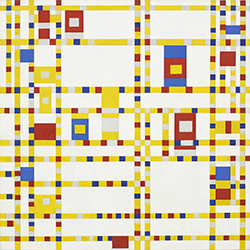 Painting by Piet Mondrian: Broadway Boogie Woogie was completed in 1943, shortly after Mondrian moved to New York in 1940. Compared to his earlier work, the canvas is divided into a much larger number of squares. Although he spent most of his career creating abstract work, this painting is inspired by clear real-world examples: the city grid of Manhattan, and the Broadway boogie woogie, a type of music Mondrian loved. The painting was bought by the Brazilian sculptor Maria Martins for the price of $800 at the Valentine Gallery in New York City, after Martins and Mondrian both exhibited there in 1943. Martins later donated the painting to the Museum of Modern Art in New York City.
Painting by Piet Mondrian: Broadway Boogie Woogie was completed in 1943, shortly after Mondrian moved to New York in 1940. Compared to his earlier work, the canvas is divided into a much larger number of squares. Although he spent most of his career creating abstract work, this painting is inspired by clear real-world examples: the city grid of Manhattan, and the Broadway boogie woogie, a type of music Mondrian loved. The painting was bought by the Brazilian sculptor Maria Martins for the price of $800 at the Valentine Gallery in New York City, after Martins and Mondrian both exhibited there in 1943. Martins later donated the painting to the Museum of Modern Art in New York City.
1943
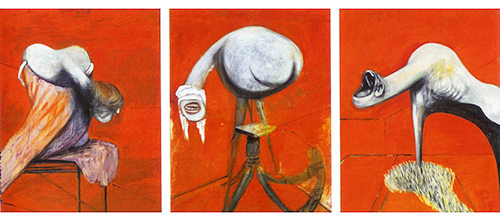 Triptych by Francis Bacon: Three Studies for Figures at the Base of a Crucifixion comprises three canvasses that are based on the Eumenides — or Furies — of Aeschylus's Oresteia, and that depict three writhing anthropomorphic creatures set against a flat burnt orange background. It was executed in oil paint and pastel on Sundeala fibre board and completed within two weeks. The triptych summarises themes explored in Bacon's previous work, including his examination of Picasso's biomorphs and his interpretations of the Crucifixion and the Greek Furies. The Three Studies are generally considered Bacon's first mature piece. When the painting was first exhibited in 1945 it caused a sensation and established him as one of the foremost post-war painters. Remarking on the cultural significance of Three Studies, the critic John Russell observed in 1971 that "there was painting in England before the Three Studies, and painting after them, and no one ... can confuse the two".
Triptych by Francis Bacon: Three Studies for Figures at the Base of a Crucifixion comprises three canvasses that are based on the Eumenides — or Furies — of Aeschylus's Oresteia, and that depict three writhing anthropomorphic creatures set against a flat burnt orange background. It was executed in oil paint and pastel on Sundeala fibre board and completed within two weeks. The triptych summarises themes explored in Bacon's previous work, including his examination of Picasso's biomorphs and his interpretations of the Crucifixion and the Greek Furies. The Three Studies are generally considered Bacon's first mature piece. When the painting was first exhibited in 1945 it caused a sensation and established him as one of the foremost post-war painters. Remarking on the cultural significance of Three Studies, the critic John Russell observed in 1971 that "there was painting in England before the Three Studies, and painting after them, and no one ... can confuse the two".
1944
Theoretical physicist Erwin Schrödinger publishes What is Life? arguing that living organisms store and pass along information, perhaps using something like Morse code. This book will inspire James Watson, Francis Crick and Maurice Wilkins, who will share the Nobel prize for discovering the structure of DNA.
O. T. Avery, C. M. MacLeod, and M. McCarty describe the pneumococcus transforming principle. The fact that it is rich in DNA suggests that DNA and not protein is the hereditary chemical.
(no entry for this year)
1945
 S. E. Luria demonstrates that mutations occur in bacterial viruses.
S. E. Luria demonstrates that mutations occur in bacterial viruses.
(no entry for this year)
1946
 Nobel Prize in Medicine awarded to H. J. Muller for his contributions to radiation genetics
Nobel Prize in Medicine awarded to H. J. Muller for his contributions to radiation genetics
Genetic recombination in bacteriophage is demonstrated by M. Delbrück and W. T. Bailey and by A. D. Hershey.
J. Lederberg and E. L. Tatum demonstrate genetic recombination in bacteria.
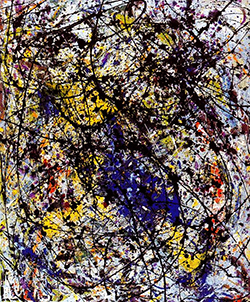 Painting by Jackson Pollock: Reflections of the Big Dipper, consisting of built up layers of paint with dripped enamel as the final touch, concluding the composition. It was around 1947 that Jackson Pollock traded in his brushes for sticks, trowels and knives and began adding foreign matter, such as sand, broken glass, nails, coins, paint-tube tops and bottle caps to his canvases. Reflection of the Big Dipper was exhibited at the Betty Parsons Gallery in 1948, along with sixteen other paintings by Jackson Pollock. The show received positive reviews. Pollock's works from this time are a transitional step between a more traditional handling of paint and his revolutionary technique of dripping paint on canvases off a large scale.
Painting by Jackson Pollock: Reflections of the Big Dipper, consisting of built up layers of paint with dripped enamel as the final touch, concluding the composition. It was around 1947 that Jackson Pollock traded in his brushes for sticks, trowels and knives and began adding foreign matter, such as sand, broken glass, nails, coins, paint-tube tops and bottle caps to his canvases. Reflection of the Big Dipper was exhibited at the Betty Parsons Gallery in 1948, along with sixteen other paintings by Jackson Pollock. The show received positive reviews. Pollock's works from this time are a transitional step between a more traditional handling of paint and his revolutionary technique of dripping paint on canvases off a large scale.
1947
(no entry for this year)
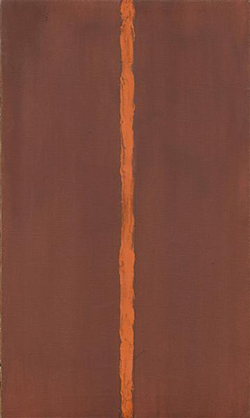 Painting by Barnett Newman: Onement I features the first full incarnation of what Newman later called a 'zip', a vertical band of color. This motif would play a central role in many of his subsequent paintings. The painting's title is an archaic derivation of the word 'atonement', meaning, "the state of being made into one."
Painting by Barnett Newman: Onement I features the first full incarnation of what Newman later called a 'zip', a vertical band of color. This motif would play a central role in many of his subsequent paintings. The painting's title is an archaic derivation of the word 'atonement', meaning, "the state of being made into one."
1948
 H. J. Muller coins the term dosage compensation.
H. J. Muller coins the term dosage compensation.
J. Lederberg and N. Zinder, and, independently, B. D. Davis develop the penicillin selection technique for isolating biochemically deficient bacterial mutants.
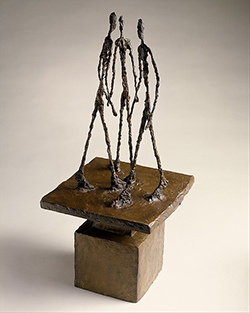 Alberto Giacometti completes Three Men Walking II
Alberto Giacometti completes Three Men Walking II
1949
A. D. Hershey and R. Rotman demonstrate that genetic recombination occurs in bacteriophage.
J. V. Neel provides genetic evidence that the sickle-cell disease is inherited as a simple Mendelian autosomal recessive.
ESP Quick Facts
ESP Origins
In the early 1990's, Robert Robbins was a faculty member at Johns Hopkins, where he directed the informatics core of GDB — the human gene-mapping database of the international human genome project. To share papers with colleagues around the world, he set up a small paper-sharing section on his personal web page. This small project evolved into The Electronic Scholarly Publishing Project.
ESP Support
In 1995, Robbins became the VP/IT of the Fred Hutchinson Cancer Research Center in Seattle, WA. Soon after arriving in Seattle, Robbins secured funding, through the ELSI component of the US Human Genome Project, to create the original ESP.ORG web site, with the formal goal of providing free, world-wide access to the literature of classical genetics.
ESP Rationale
Although the methods of molecular biology can seem almost magical to the uninitiated, the original techniques of classical genetics are readily appreciated by one and all: cross individuals that differ in some inherited trait, collect all of the progeny, score their attributes, and propose mechanisms to explain the patterns of inheritance observed.
ESP Goal
In reading the early works of classical genetics, one is drawn, almost inexorably, into ever more complex models, until molecular explanations begin to seem both necessary and natural. At that point, the tools for understanding genome research are at hand. Assisting readers reach this point was the original goal of The Electronic Scholarly Publishing Project.
ESP Usage
Usage of the site grew rapidly and has remained high. Faculty began to use the site for their assigned readings. Other on-line publishers, ranging from The New York Times to Nature referenced ESP materials in their own publications. Nobel laureates (e.g., Joshua Lederberg) regularly used the site and even wrote to suggest changes and improvements.
ESP Content
When the site began, no journals were making their early content available in digital format. As a result, ESP was obliged to digitize classic literature before it could be made available. For many important papers — such as Mendel's original paper or the first genetic map — ESP had to produce entirely new typeset versions of the works, if they were to be available in a high-quality format.
ESP Help
Early support from the DOE component of the Human Genome Project was critically important for getting the ESP project on a firm foundation. Since that funding ended (nearly 20 years ago), the project has been operated as a purely volunteer effort. Anyone wishing to assist in these efforts should send an email to Robbins.
ESP Plans
With the development of methods for adding typeset side notes to PDF files, the ESP project now plans to add annotated versions of some classical papers to its holdings. We also plan to add new reference and pedagogical material. We have already started providing regularly updated, comprehensive bibliographies to the ESP.ORG site.
ESP Picks from Around the Web (updated 06 MAR 2017 )
Old Science

Weird Science

Treating Disease with Fecal Transplantation
Fossils of miniature humans (hobbits) discovered in Indonesia

Dinosaur tail, complete with feathers, found preserved in amber.
Astronomy

Mysterious fast radio burst (FRB) detected in the distant universe.